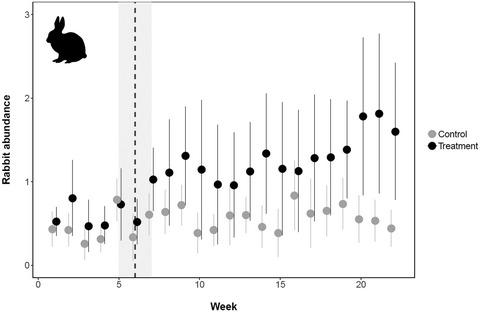当前位置:
X-MOL 学术
›
Anim. Conserv.
›
论文详情
Our official English website, www.x-mol.net, welcomes your
feedback! (Note: you will need to create a separate account there.)
Conditioned odor aversion as a tool for reducing post-release predation during animal translocations
Animal Conservation ( IF 2.8 ) Pub Date : 2020-09-21 , DOI: 10.1111/acv.12643 J. Tobajas 1 , E. Descalzo 1 , R. Villafuerte 2 , J. Jimenez 1 , R. Mateo 1 , P. Ferreras 1
Animal Conservation ( IF 2.8 ) Pub Date : 2020-09-21 , DOI: 10.1111/acv.12643 J. Tobajas 1 , E. Descalzo 1 , R. Villafuerte 2 , J. Jimenez 1 , R. Mateo 1 , P. Ferreras 1
Affiliation

|
Predation is a key factor in prey population dynamics and could impact population recovery. One common means employed to recover prey populations is that of translocations, but most fail owing to high predation during the early stages. We tested whether conditioned odor aversion can reduce predation during animal translocations by using the predation of the European rabbit Oryctolagus cuniculus by the red fox Vulpes vulpes as a case study. Following a before-after control-impact design (BACI), we deployed bait stations monitored using camera-traps in two zones to which rabbits were translocated. One week before the rabbits were released, microencapsulated levamisole was added to rabbit baits located in the treatment zones, along with vanilla essence as an odor cue. A total of 148 rabbits were distributed in artificial warrens with the odor cue and 68 of them were fitted with radio collars in order to determine their survival rates. The response to the treatment and translocation as regards subsequent rabbit abundance was evaluated using N-mixture models, while rabbit establishment was evaluated using a warren use index (WUI). The treatment decreased the proportion of baits consumed by foxes, but this decrease was partially compensated by other predators. WUI and rabbit population growth increased significantly more after translocations in the treatment zones than in the control zones. The short-term survival of translocated rabbits was also higher in the treatment zones than in the control zones. Our study showed that conditioned odor aversion reduced rabbit predation by foxes, and had a positive effect on rabbit population growth after translocation, since there was an increase in rabbit survival and warren establishment. This method could be used as a non-lethal tool for the recovery of a key prey when carrying out programs concerning the reintroduction of endangered predators or for other vulnerable species requiring translocations.
中文翻译:

有条件的气味厌恶作为减少动物易位期间释放后捕食的工具
捕食是猎物种群动态的关键因素,可能会影响种群恢复。用于恢复猎物种群的一种常用方法是易位,但由于早期阶段的高度捕食,大多数方法都失败了。我们通过使用红狐Vulpes vulpes对欧洲兔Oryctolagus cuniculus的捕食来测试条件性气味厌恶是否可以减少动物易位期间的捕食作为案例研究。遵循前后控制影响设计 (BACI),我们在兔子被转移到的两个区域部署了使用摄像机陷阱监控的诱饵站。在兔子被释放前一周,将微囊化左旋咪唑添加到位于治疗区的兔子诱饵中,并加入香草精作为气味提示。总共有 148 只兔子被分布在带有气味提示的人工饲养箱中,其中 68 只配备了无线电项圈,以确定它们的存活率。使用 N 混合物模型评估对处理和易位的后续兔丰度的反应,而使用沃伦使用指数 (WUI) 评估兔的建立。这种处理降低了狐狸消耗的诱饵比例,但这种减少被其他捕食者部分补偿。处理区易位后的 WUI 和兔种群增长显着高于对照区。处理区易位兔的短期存活率也高于对照区。我们的研究表明,条件性气味厌恶减少了狐狸对兔子的捕食,并且对易位后的兔子种群增长产生了积极影响,因为兔子的存活率和沃伦建立率都有所增加。在执行有关重新引入濒危捕食者或需要易位的其他脆弱物种的计划时,该方法可用作恢复关键猎物的非致命工具。处理区易位兔的短期存活率也高于对照区。我们的研究表明,条件性气味厌恶减少了狐狸对兔子的捕食,并且对易位后的兔子种群增长产生了积极影响,因为兔子的存活率和沃伦建立率都有所增加。在执行有关重新引入濒危捕食者或需要易位的其他脆弱物种的计划时,该方法可用作恢复关键猎物的非致命工具。处理区易位兔的短期存活率也高于对照区。我们的研究表明,条件性气味厌恶减少了狐狸对兔子的捕食,并且对易位后的兔子种群增长产生了积极影响,因为兔子的存活率和沃伦建立率都有所增加。在执行有关重新引入濒危捕食者或其他需要易位的脆弱物种的计划时,该方法可用作恢复关键猎物的非致命工具。因为兔子的存活率和沃伦建立率都有所增加。在执行有关重新引入濒危捕食者或需要易位的其他脆弱物种的计划时,该方法可用作恢复关键猎物的非致命工具。因为兔子的存活率和沃伦建立率都有所增加。在执行有关重新引入濒危捕食者或需要易位的其他脆弱物种的计划时,该方法可用作恢复关键猎物的非致命工具。
更新日期:2020-09-21
中文翻译:

有条件的气味厌恶作为减少动物易位期间释放后捕食的工具
捕食是猎物种群动态的关键因素,可能会影响种群恢复。用于恢复猎物种群的一种常用方法是易位,但由于早期阶段的高度捕食,大多数方法都失败了。我们通过使用红狐Vulpes vulpes对欧洲兔Oryctolagus cuniculus的捕食来测试条件性气味厌恶是否可以减少动物易位期间的捕食作为案例研究。遵循前后控制影响设计 (BACI),我们在兔子被转移到的两个区域部署了使用摄像机陷阱监控的诱饵站。在兔子被释放前一周,将微囊化左旋咪唑添加到位于治疗区的兔子诱饵中,并加入香草精作为气味提示。总共有 148 只兔子被分布在带有气味提示的人工饲养箱中,其中 68 只配备了无线电项圈,以确定它们的存活率。使用 N 混合物模型评估对处理和易位的后续兔丰度的反应,而使用沃伦使用指数 (WUI) 评估兔的建立。这种处理降低了狐狸消耗的诱饵比例,但这种减少被其他捕食者部分补偿。处理区易位后的 WUI 和兔种群增长显着高于对照区。处理区易位兔的短期存活率也高于对照区。我们的研究表明,条件性气味厌恶减少了狐狸对兔子的捕食,并且对易位后的兔子种群增长产生了积极影响,因为兔子的存活率和沃伦建立率都有所增加。在执行有关重新引入濒危捕食者或需要易位的其他脆弱物种的计划时,该方法可用作恢复关键猎物的非致命工具。处理区易位兔的短期存活率也高于对照区。我们的研究表明,条件性气味厌恶减少了狐狸对兔子的捕食,并且对易位后的兔子种群增长产生了积极影响,因为兔子的存活率和沃伦建立率都有所增加。在执行有关重新引入濒危捕食者或需要易位的其他脆弱物种的计划时,该方法可用作恢复关键猎物的非致命工具。处理区易位兔的短期存活率也高于对照区。我们的研究表明,条件性气味厌恶减少了狐狸对兔子的捕食,并且对易位后的兔子种群增长产生了积极影响,因为兔子的存活率和沃伦建立率都有所增加。在执行有关重新引入濒危捕食者或其他需要易位的脆弱物种的计划时,该方法可用作恢复关键猎物的非致命工具。因为兔子的存活率和沃伦建立率都有所增加。在执行有关重新引入濒危捕食者或需要易位的其他脆弱物种的计划时,该方法可用作恢复关键猎物的非致命工具。因为兔子的存活率和沃伦建立率都有所增加。在执行有关重新引入濒危捕食者或需要易位的其他脆弱物种的计划时,该方法可用作恢复关键猎物的非致命工具。











































 京公网安备 11010802027423号
京公网安备 11010802027423号